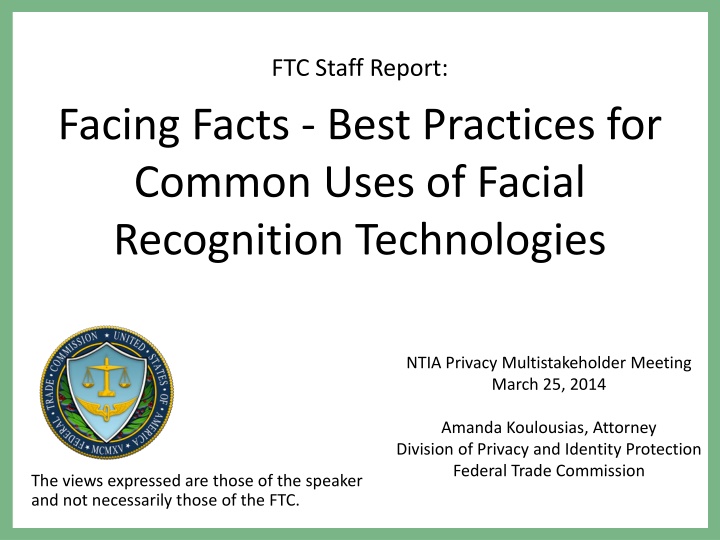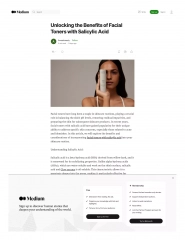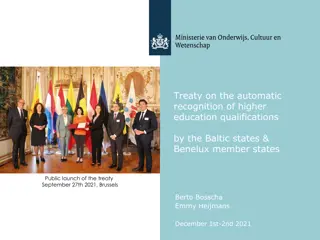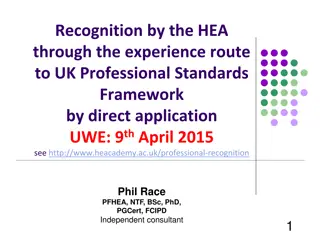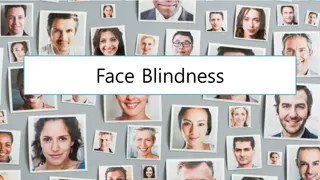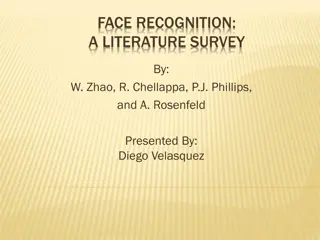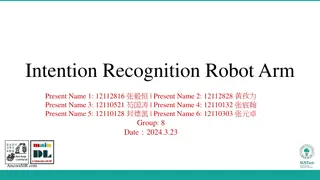Best Practices for Facial Recognition Technologies
This content discusses the best practices, recommendations, and case studies related to the common uses of facial recognition technologies as outlined in various reports and forums facilitated by the Federal Trade Commission (FTC). It covers topics such as privacy concerns, consumer benefits, transparency, and implementing principles for privacy protection.
Download Presentation

Please find below an Image/Link to download the presentation.
The content on the website is provided AS IS for your information and personal use only. It may not be sold, licensed, or shared on other websites without obtaining consent from the author.If you encounter any issues during the download, it is possible that the publisher has removed the file from their server.
You are allowed to download the files provided on this website for personal or commercial use, subject to the condition that they are used lawfully. All files are the property of their respective owners.
The content on the website is provided AS IS for your information and personal use only. It may not be sold, licensed, or shared on other websites without obtaining consent from the author.
E N D
Presentation Transcript
FTC Staff Report: Facing Facts - Best Practices for Common Uses of Facial Recognition Technologies NTIA Privacy Multistakeholder Meeting March 25, 2014 Amanda Koulousias, Attorney Division of Privacy and Identity Protection Federal Trade Commission The views expressed are those of the speaker and not necessarily those of the FTC.
Face Facts: A Forum on Facial Recognition Technology December 8, 2011 Panelists discussed a range of technologies: pure facial detection age and gender recognition emotion recognition facial recognition Major topics included: Advances in the technology Current and potential future commercial uses Benefits & privacy concerns
Public Comment Period December 2011 - January 2012 Issues for comment included: Current and future uses Benefits to consumers Privacy and security concerns Best practices for building privacy into products and when and how to provide consumers with notice and choice The FTC received 80 public comments from a variety of stakeholders
FTC Staff Report: Facing Facts Best Practices for Common Uses of Facial Recognition Technologies October 2012 Important Points: The report contains recommendations for best practices It is not a template for law enforcement actions or regulations under laws currently enforced by the FTC The recommendations build on the workshop and the public comments The report uses 3 case studies as an example to discuss best practices
FTC Staff Report: Facing Facts Best Practices for Common Uses of Facial Recognition Technologies October 2012 The recommendations describe how companies can implement the principles contained in the FTC s March 2012 Privacy Report: Privacy by Design Simplified Consumer Choice Transparency
Case Study: Detection or Recognition of Demographic Characteristics in Digital Signs Simplified Choice & Increased Transparency: Privacy by Design: Reasonable data security protections to prevent unauthorized access to the images Clear notice to consumers that these signs are in use before the consumer comes into contact with the sign No signs in sensitive areas Obtain affirmative express consent before individually identifying consumers through these signs Limited data retention
Case Study: Facial Recognition in Online Social Networks Privacy by Design: Reasonable data security for the database of images & biometric data Protections in place to prevent unauthorized scraping of publicly available images in the database Appropriate retention and disposal practices
Case Study: Facial Recognition in Online Social Networks (continued) Simplified Choice and Increased Transparency: Clear notice outside of a privacy policy when the feature is rolled out Offer consumers an easy to find choice not to have biometric data collected and used for facial recognition Do not collect or store biometric data of non-users of the service because there is no context in which to provide such non-users with a choice about these practices
Case Study: Facial Recognition in Online Social Networks (continued) Situations in which affirmative express consent should be obtained: Before using a consumer s image or biometric data in a materially different manner than represented when the company collected the data Identifying a user to another user who is not their friend Recommendation applies beyond social networks: Only identify anonymous images of consumers to someone who could not otherwise identify them if the consumer has affirmatively opted in to such a system
